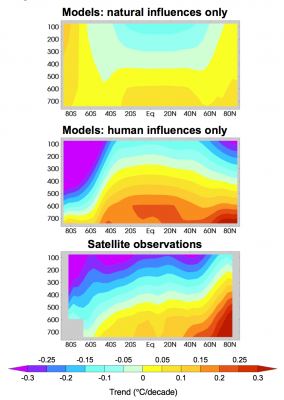Human and Natural Influences on the Changing Thermal Structure of the Atmosphere
Objective
- To compare modeled and observed patterns of the vertical structure of atmospheric temperature change
Research
- To determine whether anthropogenic “fingerprint” is statistically identifiable in satellite observations
- To determine whether identification of a human-caused fingerprint is robust to current uncertainties in climate models and observations
- A human-caused latitude/altitude pattern of atmospheric temperature change can be identified with high statistical confidence in satellite data – we show clear evidence of a discernible human influence on the thermal structure of the atmosphere
- A human-caused fingerprint is identifiable not only relative to internal “climate noise”, but also relative to the larger total natural variability arising from changes in solar irradiance and volcanic forcing
Observational satellite data and the computer model response to human influence have a common pattern of changes in the thermal structure of the atmosphere. The key features of this pattern are global-scale tropospheric warming and stratospheric cooling over the 34-year satellite temperature record. We show that current climate models are highly unlikely to produce this distinctive signal pattern by internal variability alone, or in response to naturally forced changes in solar output and volcanic aerosol loadings. We detect a “human influence” signal in all cases, even if we test against natural variability estimates with much larger fluctuations in solar and volcanic influences than those we have observed since 1979. Our results highlight the very unusual nature of observed changes in atmospheric temperature.

